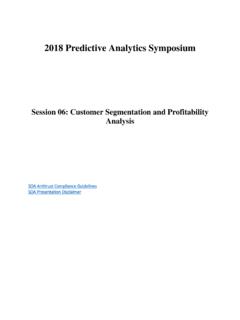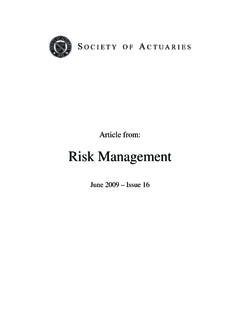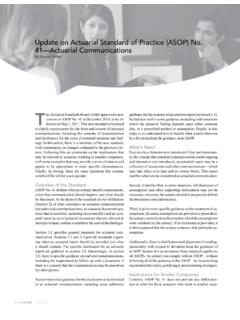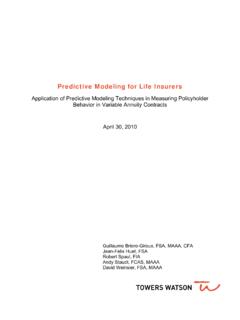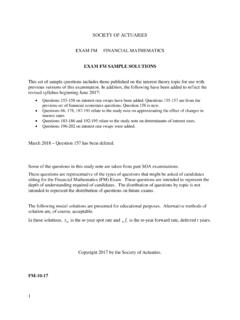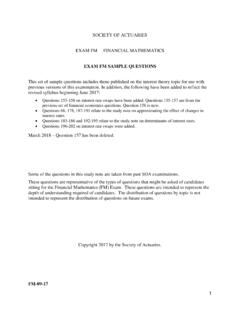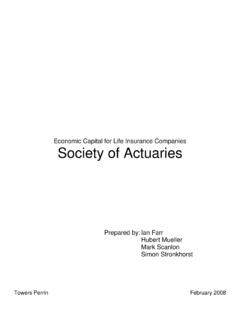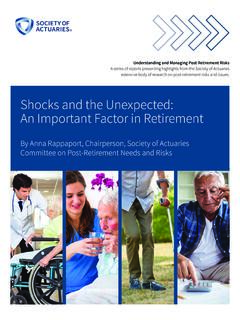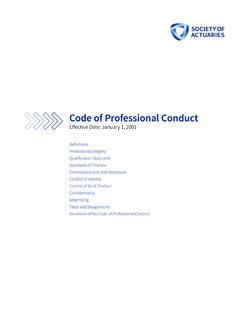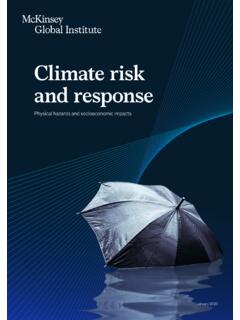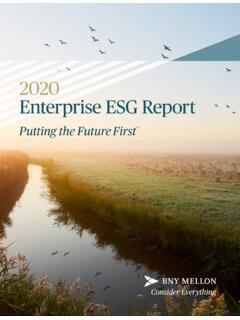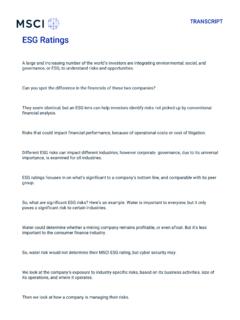Transcription of Economic Scenario Generators - MEMBER
1 Economic Scenario Generators A Practical Guide July 2016 2 2016 Society of Actuaries Economic Scenario Generators A Practical Guide SPONSORS Committee on Finance Research Research Expanding Boundaries Pool AUTHORS Hal Pedersen, ASA, Mary Pat Campbell, FSA, MAAA Stephan L. Christiansen, FCAS, MAAA Samuel H. Cox, , FSA, CERA Daniel Finn, FCAS, ASA Ken Griffin, CFA, ASA, MAAA Nigel Hooker, , FIA Matthew Lightwood, , BSC (HONS) Stephen M. Sonlin, CFA Chris Suchar, FCAS, MAAA Caveat and Disclaimer The opinions expressed and conclusions reached by the authors are their own and do not represent any official position or opinion of the Society of Actuaries or its members. The Society of Actuaries makes no representation or warranty to the accuracy of the information. Copyright 2016 All rights reserved by the Society of Actuaries 3 2016 Society of Actuaries CONTENTS 6 Acknowledgments.
2 6 Executive Summary .. 7 1. WHAT IS AN Economic Scenario GENERATOR? .. 7 2. WHY HAVE Economic Scenario Generators EMERGED AS AN IMPORTANT TOOL TO SOLVE RISK MANANAGEMENT PROBLEMS? .. 7 3. HOW DO ESGS HELP SATISFY REGULATORY REQUIREMENTS? .. 8 4. WHAT ARE THE SPECIFIC BUSINESS APPLICATIONS OF ESGS IN THE INSURANCE AND PENSIONS INDUSTRIES?.. 9 5. WHAT ARE THE ESSENTIAL FEATURES OF A COMPREHENSIVE ESG? .. 9 6. CONSIDERATIONS OF MODEL SPECIFICATION AND STYLIZED FACTS .. 10 7. MODEL CALIBRATION AND PARAMETERIZATION .. 11 8. VALIDATION .. 11 9. ARBITRAGE-FREE MODELING CONSIDERATIONS .. 12 10. RISK-NEUTRAL scenarios .. 13 11. DEFAULT-FREE INTEREST RATE MODELS .. 14 12. CORPORATE BOND (YIELD) MODELS .. 15 13. EQUITY INDEX MODELS .. 15 14. INTERNATIONAL CONSIDERATIONS .. 16 Chapter 1: What Is an Economic Scenario Generator? .. 18 OVERVIEW OF ESG MODELS .. 18 ESG MODEL COMPONENTS .. 20 RELATIONSHIPS BETWEEN MODEL COMPONENTS .. 22 STRUCTURAL ESG MODEL COMPONENTS .. 22 CHAPTER SUMMARY.
3 22 CHAPTER REFERENCES .. 23 Chapter 2: The Need for Economic Scenario Generators .. 24 SIMULATION VERSUS ANALYTICAL SOLUTIONS .. 24 ANALYTICS AND SIMULATION: AN ILLUSTRATION .. 26 HISTORICAL CONTEXT: THE BIG BANG AND EMERGENCE OF ESGS .. 29 ESG MODEL APPLICATIONS .. 31 HOW ESGS DIFFER FROM OTHER Economic MODELS .. 31 LIMITATIONS OF ESG APPROACHES .. 32 CHAPTER SUMMARY .. 34 CHAPTER REFERENCES .. 34 Chapter 3: The Role of ESGs in Satisfying Regulatory Requirements .. 35 APPLICATIONS OF ESGS IN RESPONDING TO EVOLVING REGULATORY REQUIREMENTS .. 35 SPECIFIC REGULATORY REQUIREMENTS WITH RESPECT TO 40 GENERAL REGULATORY ESG CONSIDERATIONS .. 41 CHAPTER SUMMARY .. 43 CHAPTER REFERENCES .. 44 Chapter 4: Business Applications of ESGs in the Insurance and Pension Industries .. 45 LIFE INSURANCE APPLICATIONS .. 45 PENSION AND RETIREMENT APPLICATIONS .. 49 PROPERTY AND CASUALTY (P&C) APPLICATIONS .. 51 CHAPTER SUMMARY .. 54 4 2016 Society of Actuaries Chapter 5: What Are the Essential Features of a Good ESG?
4 55 REAL WORLD VERSUS MARKET CONSISTENT .. 55 ESSENTIAL FEATURES OF A GOOD ESG .. 56 ADVANCED ESG ATTRIBUTES .. 61 HOW GOOD IS AN ESG, REALLY? .. 62 CHAPTER SUMMARY .. 62 CHAPTER REFERENCES .. 62 Chapter 6: Considerations of Model Specification and Stylized 63 STYLIZED FACTS .. 63 CONSIDERATIONS IN THE DETERMINATION OF STYLIZED FACTS .. 64 OVERVIEW OF COMMONLY MODELED Economic AND FINANCIAL VARIABLES .. 68 OVERVIEW OF THE EQUITY MARKETS .. 77 CHAPTER SUMMARY .. 77 APPENDIX: DATA SOURCES .. 78 CHAPTER REFERENCES .. 79 Chapter 7: Model Calibration and Parameterization .. 80 THE CALIBRATION PROCESS .. 80 CALIBRATIONS OF MARKET-CONSISTENT ESG MODELS .. 81 PARAMETERIZATION (CALIBRATION) OF REAL-WORLD ESG MODELS .. 83 METHODS OF PARAMETERIZING REAL-WORLD ESGS .. 85 CHAPTER SUMMARY .. 86 CHAPTER REFERENCES .. 86 Chapter 8: Model Validation .. 88 GENERAL CONSIDERATIONS IN DEVELOPING A VALIDATION SYSTEM .. 88 SPECIFIC CONSIDERATIONS IN VALIDATION OF REAL-WORLD ESGS.
5 90 VALIDATION OF MARKET-CONSISTENT ESGS .. 93 VALIDATION: FINAL THOUGHTS .. 95 CHAPTER SUMMARY .. 96 CHAPTER REFERENCES .. 96 Chapter 9: Arbitrage-Free Modeling Considerations .. 97 ARBITRAGE-FREE FINANCIAL MODELS .. 97 APPLYING A PRACTICAL APPLICATION .. 99 IS THE ARBITRAGE-FREE FRAMEWORK NECESSARY? .. 100 MARTINGALE TESTS .. 101 CHAPTER SUMMARY .. 102 CHAPTER REFERENCES .. 102 Chapter 10: The Role of Risk-Neutral scenarios .. 104 WHAT DOES RISK-NEUTRAL MEAN? .. 105 APPLICATIONS OF MARTINGALE TESTS IN PRACTICE .. 107 WHAT IS THE PURPOSE OF RISK-NEUTRAL scenarios ? .. 109 DECIDING BETWEEN REAL-WORLD AND RISK-NEUTRAL scenarios .. 110 WHEN ARE REAL-WORLD AND RISK-NEUTRAL scenarios USED TOGETHER? .. 111 CHAPTER SUMMARY .. 111 CHAPTER REFERENCES .. 112 Chapter 11: Default-Free Interest Rate Models .. 113 IMPORTANT PROPERTIES OF ROBUST INTEREST RATE MODELS .. 113 BINOMIAL INTEREST RATE MODELS .. 115 CONTINUOUS-TIME SINGLE-FACTOR MODELS OF THE TERM STRUCTURE.
6 121 MORE ADVANCED MODELS FOR THE TERM STRUCTURE .. 134 CHAPTER REFERENCES .. 142 APPENDIX: MATHEMATICAL DETAILS FOR A GENERAL SINGLE-FACTOR MODEL .. 143 5 2016 Society of Actuaries Chapter 12: Corporate Bond Models .. 151 DEFINITION AND KEY CONSIDERATIONS OF THE CORPORATE BOND 151 THE MECHANISMS OF CORPORATE BOND MODELING .. 153 STRUCTURAL/MERTON MODELS .. 154 REDUCED-FORM MODELS .. 155 RATINGS-BASED 157 OTHER ISSUES .. 161 CHAPTER REFERENCES .. 161 Chapter 13: Equity Index Models .. 163 GENERAL CONSIDERATION OF EQUITY MODELS .. 163 THE STANDARD BLACK-SCHOLES MODEL .. 165 THE HESTON MODEL .. 166 THE STOCHASTIC VOLATILITY WITH JUMPS (SVJ) 166 REGIME-SWITCHING MODEL .. 167 ECONOMETRIC MODELS .. 169 CHAPTER REFERENCES .. 169 Chapter 14: International Considerations .. 170 SINGLE-ECONOMY VERSUS MULTI-ECONOMY MODELING .. 171 DETAILS OF SIMILAR ASSET CLASSES CAN VARY SIGNIFICANTLY ACROSS ECONOMIES.
7 172 DATA ISSUES IN MODELING GLOBAL ECONOMIES .. 173 THE IMPORTANCE OF CO-MOVEMENTS BETWEEN ECONOMIES .. 175 FOREIGN EXCHANGE (FX) .. 179 CONSTRUCTING GLOBAL ECONOMIES FROM SINGLE-ECONOMY MODELS .. 183 CHAPTER REFERENCES .. 183 Annotated Bibliography .. 185 INTEREST 185 CORPORATE BONDS AND CREDIT RATINGS .. 191 STOCK PRICE MODELS .. 192 INVESTMENT MODELS, Economic Scenario Generators .. 194 Glossary .. 198 About the Society of Actuaries .. Error! Bookmark not defined. 6 2016 Society of Actuaries Introduction An Economic Scenario generator (ESG) is a software tool that simulates future paths of economies and financial markets, and illuminates the nature of risk elements within the economy that drive financial variability. The analysis of a stochastic distribution of possible Economic futures, which includes unexpected but plausible outcomes, is critical for testing a business model under a wide variety of Economic conditions.
8 Applications of an ESG can range from limited tasks to broad analyses. For example, a small task might be the simulation of interest rates in order to understand the impact of interest rate changes on an investment portfolio. A broader role for an ESG could be supporting an enterprise risk management approach in order to identify and manage internal and external risks that might affect a company s financial stability and success. Some elements of regulatory regimes require firms to take into account the assumptions of internal business models in making business decisions. ESGs can provide greater transparency and specificity in satisfying such regulatory requirements. An ESG can operate in the context of a real-world environment that captures market dynamics and risks in a way that a company will experience them. Or the context can be a risk-neutral environment that enables the pricing of cash flows that depend upon stochastic financial variability, such as would be found with investment guarantees in variable annuities.
9 This publication is intended to serve as an in-depth primer on Economic Scenario Generators . The first half of the publication provides more general information on the nature of Economic Scenario Generators what they are, how they evolved and how they address regulatory and business needs in the insurance and pension industries. It also addresses essential features of a good Economic Scenario generator and provides some detailed guidance on important aspects of financial market model specification, model calibration and model validation considerations to assure that the ESG will produce simulation results that are relevant and sufficiently robust and that realistically reflect market dynamics. The second half of the publication provides technical discussion of some of the essential financial markets aspects of a comprehensive ESG. Description of arbitrage-free considerations, the role of risk-neutral scenarios , and default-free interest rate models are explored with some of the underlying mathematics necessary to understand these considerations.
10 Final chapters provide some important considerations relating to corporate bond models and equity index models, and how these considerations may extend to international and global interactions. Each chapter begins by summarizing the specific sections of the chapter and ends with key takeaway points and additional references for further exploration. The publication closes with an annotated bibliography and a glossary of key terms used throughout the publication. Acknowledgments The authors would like to thank the following members of the Project Oversight Group for their participation and contribution to the development of this publication: Dennis Radliff (Chair), David Cantor, Stephanie Ching, Russell Gao and Robert R. Reitano. 7 2016 Society of Actuaries Executive Summary 1. WHAT IS AN Economic Scenario GENERATOR? An Economic Scenario generator (ESG) is a computer-based model of an Economic environment that is used to produce simulations of the joint behavior of financial market values and Economic variables.
